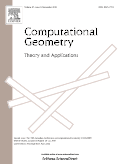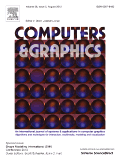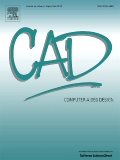
Journal for Geometry and Graphics
Scope & Guideline
Where Mathematical Theory Meets Practical Visualization
Introduction
Aims and Scopes
- Geometric Theory and Applications:
The journal emphasizes fundamental and advanced geometric theories, exploring their applications in engineering, architecture, and design. - Computational Geometry and Graphics:
Research on computational techniques for geometric constructions, modeling, and visualization is a key focus, highlighting the integration of geometry with computer graphics. - Educational Methods in Spatial Visualization:
The journal addresses methodologies for teaching and enhancing spatial visualization skills among students, particularly in technical fields such as engineering and architecture. - Interdisciplinary Approaches to Geometry:
It promotes interdisciplinary studies that connect geometry with other fields such as art, architecture, and visual sciences, showcasing the broad relevance of geometric concepts. - Innovative Design Techniques:
The journal features innovative approaches to geometric design, including origami, 3D printing, and other modern fabrication techniques.
Trending and Emerging
- 3D Printing and Origami Design:
There is an increasing interest in the application of geometric principles to 3D printing and origami, showcasing how traditional geometry can inform modern fabrication techniques. - Non-Euclidean Geometry in Applications:
The exploration of non-Euclidean geometries is gaining traction, particularly in engineering and visual arts, indicating a trend towards incorporating diverse geometric frameworks in practical applications. - Computational Design Frameworks:
Research focusing on computational methods for generating and analyzing geometric structures is becoming more prominent, emphasizing the role of technology in geometric design. - Spatial Visualization and Education:
The significance of spatial visualization skills in educational contexts is increasingly recognized, leading to a rise in studies aimed at improving these competencies among students. - Interdisciplinary Connections:
Emerging themes highlight the intersections between geometry and other fields, such as art and architecture, reflecting a growing trend towards interdisciplinary research.
Declining or Waning
- Classical Geometry Problems:
Traditional problems in geometry, such as those related to basic constructions or classical theorems, are appearing less frequently as researchers shift towards more modern applications and computational methods. - Theoretical Aspects of Geometry:
There is a noticeable waning in purely theoretical discussions surrounding geometry, with a preference for applied geometric concepts and their implications in design and technology. - Static Geometric Configurations:
Research on static configurations, such as fixed geometric shapes and properties, is being overshadowed by dynamic and computational approaches that offer more practical applications.
Similar Journals

JOURNAL OF ALGEBRAIC GEOMETRY
Connecting theory and application in algebraic geometry.JOURNAL OF ALGEBRAIC GEOMETRY is a prestigious academic journal published by UNIV PRESS INC, dedicated to the field of algebraic geometry and its intersections with number theory and topology. With its ISSN 1056-3911 and E-ISSN 1534-7486, this journal has established a robust reputation within the mathematical community, as evidenced by its impressive rankings: placed in the Q1 category for both Algebra and Number Theory and Geometry and Topology in 2023, and ranked #14 and #16 respectively in Scopus. The journal serves as a vital platform for the dissemination of cutting-edge research, fostering scholarly communication and exploration of new theories and methodologies. While currently not available as an open access publication, the JOURNAL OF ALGEBRAIC GEOMETRY offers readers access to high-quality peer-reviewed articles that contribute significantly to advancements in algebraic structures, geometric properties, and their applications. Established in 1996, the journal continues to be at the forefront of research until 2024, making it essential reading for researchers, practitioners, and students eager to expand their knowledge and engage with the latest developments in this dynamic field.

SIAM Journal on Applied Algebra and Geometry
Innovating Solutions with Algebraic and Geometric InsightsSIAM Journal on Applied Algebra and Geometry, published by SIAM Publications, is a premier academic journal that occupies a vital space in the fields of Algebra, Geometry, and Applied Mathematics. With an impressive impact factor reflected in its Q1 category rankings in 2023 across key mathematical disciplines such as Algebra and Number Theory, as well as Geometry and Topology, this journal is positioned among the highest echelons of mathematical research. Since its inception in 2017, it has become a crucial source for advanced studies and applied techniques that harness algebraic and geometric methods, catering to both theoretical insights and practical applications. Researchers, professionals, and students alike benefit from its rigorous peer-reviewed articles that explore contemporary challenges and developments in mathematics. While Open Access options are currently not available, the journal remains dedicated to fostering innovation and knowledge dissemination within the scientific community, thus ensuring significant contributions to the advancement of the mathematical sciences.

European Journal of Mathematics
Exploring the Depths of Mathematical KnowledgeWelcome to the European Journal of Mathematics, a prominent publication that serves as a vital platform for disseminating high-quality research in the field of mathematics. Published by Springer International Publishing AG, this journal has witnessed significant growth since its inception in 2015 and is recognized for its contributions within the Q2 category of Mathematics (miscellaneous) as per the 2023 rankings. With an ISSN of 2199-675X and an E-ISSN of 2199-6768, the journal aims to foster innovation and collaboration among researchers, professionals, and students alike. Although it operates under a traditional access model, the journal's commitment to advancing mathematical knowledge and applications cannot be overstated. Positioned among the top-tier publications, the European Journal of Mathematics is an essential resource that encourages the exploration of emerging trends and theories in mathematics, making it indispensable for anyone striving to stay at the forefront of this dynamic field.

JOURNAL OF VISUALIZATION
Unveiling new perspectives in condensed matter and engineering.JOURNAL OF VISUALIZATION, published by Springer, is a pioneering platform dedicated to advancing the fields of condensed matter physics, electrical and electronic engineering, and computer graphics through innovative visualization techniques. With an ISSN of 1343-8875 and an E-ISSN of 1875-8975, this esteemed journal has been an essential resource since its inception in 1998, and continues to shape the landscape of visualization research, boasting a Q2 ranking in key academic categories as of 2023. The journal's commitment to high-quality research is reflected in its Scopus rankings, where it stands at #47 in Computer Graphics and Computer-Aided Design, #388 in Electrical Engineering, and #222 in Condensed Matter Physics. While the journal subscribes to a traditional access model, it remains a critical outlet for researchers and professionals seeking to disseminate their findings amidst evolving technological and scientific paradigms. Situated in Germany, the JOURNAL OF VISUALIZATION encompasses a diverse array of articles that not only highlight theoretical advances but also practical applications, making it a vital resource for anyone engaged in the confluence of visual analytics and technology.

COMPUTATIONAL GEOMETRY-THEORY AND APPLICATIONS
Bridging Theory and Application in Computational GeometryCOMPUTATIONAL GEOMETRY - THEORY AND APPLICATIONS is a premier academic journal published by Elsevier, specializing in the interdisciplinary field of computational geometry. Since its inception in 1991, this journal has had a significant influence on the advancement of computational mathematics, offering a platform for innovative research that explores the theoretical and applied aspects of geometry and its applications in various scientific domains. With a 2023 impact factor placing it in the Q2 category for Computational Mathematics and Geometry and Topology, researchers can trust the rigor and relevance of the work published here. While the journal does not currently offer an open-access option, it remains highly influential, ranked in the mid-range percentile across multiple categories including Computational Theory and Mathematics and Control and Optimization. Therefore, it serves as an invaluable resource for researchers, professionals, and students passionate about pushing the boundaries of knowledge in computational geometry and its myriad applications. The ongoing publication commitments extend until 2025, further solidifying its role in shaping the future of this dynamic field.

Journal of Symplectic Geometry
Advancing the frontiers of symplectic geometry.Journal of Symplectic Geometry, published by INT PRESS BOSTON, INC, is a premier outlet for research in the rapidly evolving fields of geometry and topology. With an ISSN of 1527-5256 and an E-ISSN of 1540-2347, this journal has established itself as a vital resource for scholars, featuring innovative research and comprehensive surveys that delve into the intricacies of symplectic geometry and its myriad applications. Boasting an impressive Q1 ranking in Geometry and Topology for 2023, the journal is dedicated to fostering a collaborative academic environment, attracting contributions from esteemed mathematicians worldwide. While the journal maintains a subscription-based model, it continues to prioritize disseminating high-quality research that propels advancements in the field. Researchers, professionals, and students alike will find the Journal of Symplectic Geometry indispensable for staying updated on the latest developments and contributing to ongoing discussions within the symplectic community, spanning from 2009 to 2024.

COMPUTERS & GRAPHICS-UK
Innovating the Intersection of Technology and ArtCOMPUTERS & GRAPHICS-UK is a premier journal dedicated to the fields of computer graphics, computer-aided design, and human-computer interaction. Published by Pergamon-Elsevier Science Ltd, this esteemed journal has been a critical resource for researchers and professionals since its inception in 1975. With an impressive impact factor and ranked in the second quartile for key disciplines such as Computer Vision and Pattern Recognition, and Engineering (Miscellaneous), it provides a platform for high-quality, peer-reviewed research spanning theoretical advancements, innovative technologies, and practical applications. Notable for its interdisciplinary approach, the journal also embraces contributions that bridge diverse areas within computer science. Although lacking Open Access options, readers can benefit from its rich archive and cross-disciplinary insights, making it essential for anyone looking to advance their knowledge and practice in computer graphics and related fields. The journal is located in the United Kingdom, at The Boulevard, Langford Lane, Kidlington, Oxford OX5 1GB, and continues to be a cornerstone for scholarly exchange and advancement in the digital visualization domain.

COMPUTER-AIDED DESIGN
Catalyzing Progress in Computer-Aided Design and ManufacturingCOMPUTER-AIDED DESIGN is a premier journal published by Elsevier Science Ltd, dedicated to the dynamic fields of Computer Graphics and Computer-Aided Design, as well as Industrial and Manufacturing Engineering. With a long-standing history since its inception in 1968, this journal plays a vital role in disseminating high-quality research and innovative methodologies that shape the future of design and engineering practices. It is positioned in the upper quartiles (Q1 and Q2) across multiple categories, highlighting its impact and reputation, with a notable 74th percentile ranking in Computer Graphics and Computer-Aided Design related fields. Researchers, professionals, and students will find valuable insights and advancements that not only push the boundaries of knowledge but also facilitate practical applications in the industry. The journal's emphasis on enhancing collaboration between academia and industry aligns with contemporary trends towards integrated design and manufacturing processes, making it an essential resource for anyone looking to stay at the forefront of technological advancement. Authors are encouraged to submit original articles that contribute to the multidisciplinary discourse within these domains.

Journal of Fractal Geometry
Advancing Knowledge in Fractal GeometryWelcome to the Journal of Fractal Geometry, an esteemed publication in the fields of Applied Mathematics and Geometry, proudly published by the European Mathematical Society (EMS). With its open access model initiated in 2021, the journal ensures that groundbreaking research is readily available to scholars all around the globe. Since its inception, the journal has positioned itself as a vital platform for the dissemination of innovative research, focusing on the intricate study of fractal structures and their applications in various scientific domains. With an impressive H-index reflecting the journal's influence, it holds high rankings in respected databases, specifically ranking in the Q1 and Q2 quartiles for its authoritative contributions in applied mathematics as well as geometry and topology. Located in Berlin, Germany, the journal is dedicated to fostering a vibrant community of researchers, professionals, and students engaged in the beauty and complexity of fractals, making it an essential resource for advancing knowledge in this dynamic area of study.

Advanced Studies-Euro-Tbilisi Mathematical Journal
Pioneering Insights in Algebra, Analysis, and BeyondAdvanced Studies-Euro-Tbilisi Mathematical Journal, published by the esteemed TBILISI CENTRE MATH SCI, is a vital resource for scholars and practitioners in the field of mathematics. Since its inception in 2021, this journal has committed to advancing knowledge across various mathematical disciplines, including Algebra and Number Theory, Analysis, Applied Mathematics, and Geometry and Topology, although it currently holds a category quartile ranking of Q4 in all these areas. With an open-access format, it provides unparalleled access to cutting-edge research to a global audience of researchers, professionals, and students, fostering collaboration and innovation within the mathematical community. Operating from TBILISI, Georgia, the journal acknowledges the growing importance of diverse geographical contributions to mathematics and aims to spotlight emerging research trends. As research continues to evolve, Advanced Studies-Euro-Tbilisi Mathematical Journal seeks to enrich the academic dialogue and support the dissemination of mathematical knowledge.